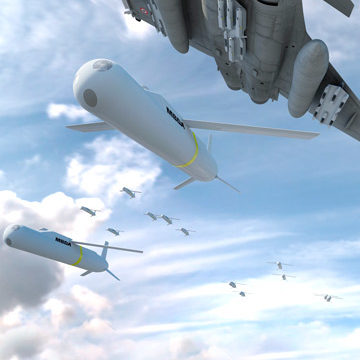The reasons for the selection of the Rafale by Colombia
Given the announcement of the pre-selection of the Dassault Rafale by the Colombian government to replace its IAI Kfir, we investigated a little more the reasons why Colombia’s preference changed in recent days from the F-16V Block 70 to the French fighter.
Negotiations for the replacement of the Kfir have been going on for ten years, having started in 2012, when requests for information were sent to the main companies, but Boeing and Dassault did not pay much attention because they believed that the Colombian Air Force (FAC) was not serious.
In 2013 manufacturers were visited, such as Boeing and Lockheed Martin in the US, Eurofighter, Dassault, the Russians that offered the MiG-35, and SAAB’s Gripen, while meetings were also held with various air forces, including Brazil.
In 2020, although there was no progress from a political point of view, the selection committee made different matrices, where the Typhoon won in all cases, and, at that time, Dassault began to pay attention to Colombia. The Typhoon's problem was high operating costs, so the F-16, then second, came to lead the selection. The F-16V was, for the FAC, “ the poor man’s F-35 ”.
However, the FAC argued that the electronic warfare systems that the air force's Kfirs have today are better than the ones offered by the factory F-16 Block 70 and Lockheed was not willing to change it, while the Python 5 missiles are better than the versions of Sidewinder offered and would not be allowed to integrate said missiles, nor the Derby nor the Spice bombs that the FAC possesses. The United States offered the F-16 only with Sidewinder and AMRAAM.
Although it was negotiated to generate a variant that integrates these systems and weapons, the FAC saw that a version that would be too specific would remain and the United States was very reluctant to go down that path. In addition, the financing was not in the best conditions and the United States also showed little openness to modifying it.
On the other hand, the FAC considered that the Gripen was not leading in any aspect, but rather, as an official who was part of the selection process explained, “was second in everything. The plane is having major integration problems in Brazil with its air-to-air and air-to-surface systems, which are not fully operational, they are in a kind of Beta version. These are problems that they do not say in public » he claimed, adding « the precision of the air-to-surface systems is not even similar to those used by the Kfir (Elbit), the F-16 and the F-35 ”.
Another problem with said plane, as reported by the FAC, is that the delivery time was very long, since Brazil and Sweden would go first and then Colombia, and the program already has significant delays.
The Eurofighter, for its part, had the problem of costs and that it is complex to maintain. It's the real winner but a very expensive one, although, at the time, they argued that some of the Rafale's operating costs are higher.
The Colombian Air Force was targeting Tranche 3 of the Typhoon, but offers had only been made for used Tranche 1 and 2 Typhoons for immediate delivery, or else new aircraft, but with very long delivery periods. Financing costs were also higher than the rest.
Faced with this panorama of intransigence from the Americans and the high costs of the Eurofighter, in addition to the limitations of the Gripen, the French decided to bet big in the middle of 2022 and start by removing the end-user restrictions, which also existed on the Gripen and the Eurofighter. In addition, they agreed to offer the integration of the Meteor missile, but also to integrate the Derby, Phyton 5 and Spice bombs, making it the most capable of all. Only the restriction on the use of nuclear weapons remains.
In addition, having a naval version, the Rafale was born with anti-ship capacity, which makes it the most multirole of all. This aspect interests Colombia because of the crises it has had with Nicaragua and Venezuela.
France also stated that it can start delivering them in one year, the shortest term of all those offered. This is essential because Kfir will be decommissioned at the end of 2023, because the support contract with IAI has already ended this year, which withdrew its people from Colombia, so sustaining the planes becomes too complicated and expensive.
The French presented their new offer to the FAC, convincing the Selection Committee, despite the fact that it had been leaning towards the F-16. The committee then agreed with Dassault, who raised the issue with French Prime Minister Emanuel Macron, who has a good relationship with Colombian President Gustavo Petro, and they achieved the first step towards an agreement between the governments.
As indicated by the Selection Committee, they were convinced because they were able to solve multiple issues. On the one hand, the Rafale’s electronic warfare capacity is customizable and Colombia was given access to the database to be able to modify it. The Rafale can integrate Israeli weaponry, employment restrictions have been lifted, it has built-in anti-ship capability and has specific weapons for the Rafale and is combat proven. Another advantage is that, since it was designed to operate on aircraft carriers, it can operate on short runways, which the Typhoon and the F-16 cannot. This allows them to operate in places like Tres Esquinas, Grupo Aéreo del Oriente and San Andrés. Furthermore, it requires less logistical support and is more versatile to operate. They also highlighted that it is a more maneuverable aircraft with a better power-to-weight ratio, in addition to the fact that, among other factors, the Rafale has an AESA radar with better coverage than the F-16’s, as the F-16’s radar has a fixed antenna with only electronic scan while the Rafale’s radar antenna can move side to side. [NOTE: THIS IS CLEARLY INCORRECT]
The Kfir costs almost 18,000 dollars per flight hour, almost as much as the Eurofighter (it is expensive because there are almost no operators or spare parts or support). The Rafale ranges between 15,000 to 17,000, the Eurofighter from 19,000 to 21,000, the F-16 from 9,500 to 11,000, and the Gripen from 7,500 to 8,000.
Thus, the Rafale has operating costs equal to the Kfir, but with many more capabilities. As they explained, the Rafale consumes 35% less fuel per engine, which makes it more cost-efficient, especially in short missions and without using afterburner.
Regarding the funds, since 2017 the National Council for Economic and Social Policy (CONPES) issued the document that reserves the funds for the purchase, so it would not affect other resources, such as those generated by the tax reform.
Although the government highlights the offset conditions, the reality is that they all offered it and, according to the FAC, the scheme proposed by the Swedes was the best.
Thus, now it remains for the detailed negotiation of the terms of the agreement to be carried out and then the signing of a contract, which could take place in the first months of 2023.














 https://www.timesofisrael.com/iaf-french-air-force-hold-joint-strike-drills-over-israels-skies/amp/
https://www.timesofisrael.com/iaf-french-air-force-hold-joint-strike-drills-over-israels-skies/amp/

